Cauliflower
| Cauliflower | |
|---|---|
|
Cauliflower, cultivar unknown | |
| Species | Brassica oleracea |
| Cultivar group | Botrytis Group |
| Origin | Northeast Mediterranean |
| Cultivar group members | Many; see text. |

Cauliflower is one of several vegetables in the species Brassica oleracea in the genus Brassica, which is in the family Brassicaceae. It is an annual plant that reproduces by seed. Typically, only the head is eaten – the edible white flesh sometimes called "curd" (with a similar appearance to cheese curd).[1] The cauliflower head is composed of a white inflorescence meristem. Cauliflower heads resemble those in broccoli, which differs in having flower buds as the edible portion. Brassica oleracea also includes broccoli, brussels sprouts, cabbage, collard greens, and kale, collectively called "cole" crops,[2] though they are of different cultivar groups.
History
In the 1st century AD, Pliny included what he called cyma among his descriptions of cultivated plants in Natural History: "Ex omnibus brassicae generibus suavissima est cyma,"[3] ("Of all the varieties of cabbage the most pleasant-tasted is cyma").[4] Pliny's descriptions likely refer to the flowering heads of an earlier cultivated variety of Brassica oleracea, but comes close to describing modern cauliflower.[5] It is found in the writings of the Arab botanists Ibn al-'Awwam and Ibn al-Baitar, in the 12th and 13th centuries when its origins were said to be Cyprus.[6][7]
François Pierre La Varenne employed chouxfleurs in Le cuisinier françois.[8] They were introduced to France from Genoa in the 16th century, and are featured in Olivier de Serres' Théâtre de l'agriculture (1600), as cauli-fiori "as the Italians call it, which are still rather rare in France; they hold an honorable place in the garden because of their delicacy",[9] but they did not commonly appear on grand tables until the time of Louis XIV.[10] It was introduced to India in 1822 from England by the British.[11]
Etymology
The word "cauliflower" derives from the Italian caoli fiori, meaning "cabbage flower".[12] The ultimate origin of the name is from the Latin words caulis (cabbage) and flōs (flower).[13]
Horticulture
Cauliflower is relatively difficult to grow compared to cabbage, with common problems such as an underdeveloped head and poor curd quality.[2]
Climate
As weather is a limiting factor for producing cauliflower, the plant grows best in cool daytime temperatures 70–85 °F (21–29 °C), with plentiful sun, and moist soil conditions high in organic matter and sandy soils.[1] The earliest maturity possible for cauliflower is 7 to 12 weeks from transplanting.[2] In the northern hemisphere, fall season plantings in July may enable harvesting before autumn frost.[1]
Long periods of sun exposure in hot summer weather may cause cauliflower heads to discolor with a red-purple hue.[1]
Seeding and transplanting
Transplantable cauliflowers can be produced in containers as flats, hotbeds, or in the field. In soil that is loose, well-drained and fertile, field seedlings are shallow-planted 0.5 inches (1.3 cm) and thinned by ample space (about 12 plants per 1 foot (30 cm).[1] Ideal growing temperatures are about 65 °F (18 °C) when seedlings are 25 to 35 days old.[1] Applications of fertilizer to developing seedlings begin when leaves appear, usually with a starter solution weekly.
Transplanting to the field normally begins late spring and may continue until mid-summer. Row spacing is about 15–18 inches (38–46 cm). Rapid vegetative growth after transplanting may benefit from such procedures as avoiding spring frosts, using starter solutions high in phosphorus, irrigating weekly, and applying fertilizer.[1]
Disorders, pests and diseases
The most important disorders affecting cauliflower quality are a hollow stem, stunted head growth or buttoning, ricing, browning and leaf-tip burn.[1] Among major pests affecting cauliflower are aphids, root maggots, cutworms, moths, and flea beetles.[2] The plant is susceptible to black rot, black leg, club root, black leaf spot, and downy mildew.[1]
Harvesting
When cauliflower is mature, heads appear as clear white, compact, and 6–8 inches (15–20 cm) in diameter, and should be cooled shortly after harvest.[1] Forced air cooling to remove heat from the field during hot weather may be needed for optimal preservation. Short-term storage is possible using cool, high-humidity storage conditions.[1]
Classification and identification
Major groups
There are four major groups of cauliflower.[14]
- Italian
- This specimen is diverse in appearance, biennial and annual in type. This group also includes white, Romanesco, various brown, green, purple, and yellow cultivars. This type is the ancestral form from which the others were derived.
- Northern European annuals
- Used in Europe and North America for summer and fall harvest, it was developed in Germany in the 18th century, and includes the old cultivars Erfurt and Snowball.
- Northwest European biennial
- Used in Europe for winter and early spring harvest, this was developed in France in the 19th century, and includes the old cultivars Angers and Roscoff.
- Asian
- A tropical cauliflower used in China and India, it was developed in India during the 19th century from the now-abandoned Cornish type,[15] and includes old varieties Early Benaras and Early Patna.
Varieties
There are hundreds of historic and current commercial varieties used around the world. A comprehensive list of about 80 North American varieties is maintained at North Carolina State University.[16]
Colours
- White
- White cauliflower is the most common color of cauliflower having a contrasting white head (also called "curd") surrounded by green leaves.[1]
- Orange
- Orange cauliflower (B. oleracea L. var. botrytis) contains beta-carotene as the orange pigment, a provitamin A compound. This orange trait originated from a natural mutant found in a cauliflower field in Canada.[17] Cultivars include 'Cheddar' and 'Orange Bouquet'.
- Green
- Green cauliflower, of the B. oleracea botrytis group, is sometimes called broccoflower. It is available in the normal curd (head) shape and with a fractal spiral curd called Romanesco broccoli. Both have been commercially available in the U.S. and Europe since the early 1990s. Green-headed varieties include 'Alverda', 'Green Goddess' and 'Vorda'. Romanesco varieties include 'Minaret' and 'Veronica'.
- Purple
- The purple color in this cauliflower is caused by the presence anthocyanins, water-soluble pigments that are found in many other plants and plant-based products, such as red cabbage and red wine.[18] Varieties include 'Graffiti' and 'Purple Cape'.
- In Great Britain and southern Italy, a broccoli with tiny flower buds is sold as a vegetable under the name "purple cauliflower"; it is not the same as standard cauliflower with a purple head.
 White and green cauliflower
White and green cauliflower- Green Romanesco cauliflower
- Orange cauliflower
 Purple cauliflower
Purple cauliflower
Production
| Cauliflower production – 2016 | |
|---|---|
| Country | Production (millions of tonnes) |
In 2016, global production of cauliflowers (combined for production reports with broccoli) was 25.2 million tonnes, led by China and India which, combined, had 73% of the world total.[19] Secondary producers, having 0.4–1.3 million tonnes annually, were the United States, Spain, Mexico and Italy.[19]
Nutrition
| Nutritional value per 100 g (3.5 oz) | |
|---|---|
| Energy | 104 kJ (25 kcal) |
|
5 g | |
| Sugars | 1.9 g |
| Dietary fiber | 2 g |
|
0.3 g | |
|
1.9 g | |
| Vitamins | Quantity %DV† |
| Thiamine (B1) |
4% 0.05 mg |
| Riboflavin (B2) |
5% 0.06 mg |
| Niacin (B3) |
3% 0.507 mg |
| Pantothenic acid (B5) |
13% 0.667 mg |
| Vitamin B6 |
14% 0.184 mg |
| Folate (B9) |
14% 57 μg |
| Vitamin C |
58% 48.2 mg |
| Vitamin E |
1% 0.08 mg |
| Vitamin K |
15% 15.5 μg |
| Minerals | Quantity %DV† |
| Calcium |
2% 22 mg |
| Iron |
3% 0.42 mg |
| Magnesium |
4% 15 mg |
| Manganese |
7% 0.155 mg |
| Phosphorus |
6% 44 mg |
| Potassium |
6% 299 mg |
| Sodium |
2% 30 mg |
| Zinc |
3% 0.27 mg |
| Other constituents | Quantity |
| Water | 92 g |
|
| |
| |
|
†Percentages are roughly approximated using US recommendations for adults. Source: USDA Nutrient Database | |
100 grams of raw white cauliflower provides 25 calories, is low in fat, carbohydrates, dietary fiber and protein (table).[20] It has a high content (20% or more of the Daily Value, DV) of vitamin C and moderate levels (10-19% DV) of several B vitamins and vitamin K (table).[20]
Phytochemicals
Cauliflower contains several phytochemicals, common in the cabbage family, that are under preliminary research for their potential properties, including isothiocyanates and glucosinolates.[21]
Boiling reduces the levels of cauliflower compounds, with losses of 20–30% after five minutes, 40–50% after ten minutes, and 75% after thirty minutes.[22] However, other preparation methods, such as steaming, microwaving, and stir frying, have no significant effect on the compounds.[22]
Cooking
.jpg)
Cauliflower heads can be roasted, boiled, fried, steamed, pickled, or eaten raw. When cooking, the outer leaves and thick stalks are typically removed, leaving only the florets (the edible "curd" or "head").[1] The leaves are also edible, but are most often discarded.[23] The florets should be broken into similar-sized pieces so they are cooked evenly. After eight minutes of steaming, or five minutes of boiling, the florets should be soft, but not mushy (depending on size). Stirring while cooking can break the florets into smaller, uneven pieces.
Cauliflower-based doughs for making pizza have been 3D printed.[24] The process involves a computer-operated program that exudes dough, tomato sauce, and cheese from a series of ports onto a sheet in less than one minute.[25]
 Cauliflower as a velouté sauce
Cauliflower as a velouté sauce
Fractal dimension
Cauliflower has been noticed by mathematicians for its distinct fractal dimension,[26][27] predicted to be about 2.8.[28][29] One of the fractal properties of cauliflower is that every branch, or "module", is similar to the entire cauliflower. Another quality, also present in other plant species, is that the angle between "modules," as they become more distant from the center, is 360 degrees divided by the golden ratio.[30]

References
- 1 2 3 4 5 6 7 8 9 10 11 12 13 Vincent A. Fritz; Carl J. Rosen; Michelle A. Grabowski; William D. Hutchison; Roger L. Becker; Cindy Tong; Jerry A. Wright & Terry T. Nennich (2017). "Growing broccoli, cabbage and cauliflower in Minnesota". University of Minnesota Extension, Garden - Growing Vegetables. Retrieved 26 February 2017.
- 1 2 3 4 "Cabbage, Broccoli, Cauliflower, and Other Brassica Crops". Center for Agriculture, Food and the Environment, College of Natural Sciences, University of Massachusetts at Amherst, USA. 14 January 2013. Retrieved 26 February 2017.
- ↑ Pliny (the Elder) (1841). Weise, C.H., ed. Historiae Naturalis Libri XX (in Latin). p. 249.
- ↑ Rackham, H., ed. (1949). "XXXV". Pliny's Natural History. Archived from the original on 1 January 2017. Retrieved 1 July 2015.
- ↑ Crozier, Arthur Alger (1891). The Cauliflower. Ann Arbor, Michigan: Register Publishing Co. p. 12.
- ↑ "Cabbage Flowers for Food". Aggie Horticulture. Texas AgriLife Extension Service, Texas A&M System. Retrieved 12 October 2014.
- ↑ Fenwick, G. Roger; Heaney, Robert K.; Mullin, W. John; VanEtten, Cecil H. (1982). "Glucosinolates and their breakdown products in food and food plants". C R C Critical Reviews in Food Science and Nutrition. 18 (2): 123–201. doi:10.1080/10408398209527361.
- ↑ Wheaton, Barbara Ketcham (1996) Savoring the Past: the French kitchen and table from 1300 to 1789, Touchstone, p. 118, ISBN 0-684-81857-4.
- ↑ Wheaton, Barbara Ketcham (1996) Savoring the Past: the French kitchen and table from 1300 to 1789, Touchstone, p. 66, ISBN 0-684-81857-4.
- ↑ Toussaint-Samat, Maguelonne (2009) A History of Food, 2nd ed., John Wiley & Sons, pp. 625f, ISBN 1-4443-0514-X.
- ↑ Vegetable Crops. New India Publishing. 1 January 2007. p. 209. ISBN 978-81-89422-41-7.
- ↑ "cauliflower". WordReference.com Dictionary of English. Retrieved 4 June 2018.
- ↑ "Cauliflower: definition". Reference.com. 2006. Retrieved 22 November 2008.
- ↑ Crisp, P. (1982). "The use of an evolutionary scheme for cauliflowers in screening of genetic resources". Euphytica. 31 (3): 725. doi:10.1007/BF00039211.
- ↑ Swarup, V.; Chatterjee, S.S. (1972). "Origin and genetic improvement of Indian cauliflower". Economic Botany. 26 (4): 381–393. doi:10.1007/BF02860710.
- ↑ Farnham, M. (2007). "Vegetable Cultivar Descriptions for North America:Cauliflower". Retrieved 2007-09-19.
- ↑ Dickson, M.H.; Lee C.Y.; Blamble A.E. (1988). "Orange-curd high carotene cauliflower inbreds, NY 156, NY 163, and NY 165". HortScience. 23: 778–779.
- ↑ Chiu, L.; Prior, R.L.; Wu, X.; Li, L. (July 16, 2005). "Toward Identification of the Candidate Gene Controlling Anthocyanin Accumulation in Purple Cauliflower (Brassica oleracea L. var. botrytis)". American Society of Plant Biologists Annual Meeting. p. 628.
- 1 2 3 "Production/Crops, Quantities by Country for Cauliflowers and Broccoli for 2016". Food and Agricultural Organization of the United Nations, Statistics Division (FAOSTAT). 2016. Retrieved 26 February 2017.
- 1 2 "Cauliflower Nutrient Data, Raw per 100 g". USDA National Nutrient Database, Release 28. 2014. Retrieved 15 May 2013.
- ↑ Ishida M, Hara M, Fukino N, Kakizaki T, Morimitsu Y (2014). "Glucosinolate metabolism, functionality and breeding for the improvement of Brassicaceae vegetables". Breed Sci. 64 (1): 48–59. doi:10.1270/jsbbs.64.48. PMC 4031110. PMID 24987290.
- 1 2 Warwick Medical School, University of Warwick (2007-05-15). "Research Says Boiling Broccoli Ruins Its Anti Cancer Properties".
- ↑ Stephens, MJ (1998). "Secondary Edible Parts of Vegetables". Vegetarian. 5.
- ↑ "Vegan Cauliflower-Based Pizza Crust, Now in 3D". Veg news. Retrieved 21 April 2017.
- ↑ Leanna Garfield (4 March 2017). "This robot can 3D-print and bake a pizza in six minutes".
- ↑ Walker, John. (2005-03-22) Fractal Food. Fourmilab.ch. Retrieved on 2013-09-03.
- ↑ Description of the Julia sets of the cabbage fractal. Iwriteiam.nl. Retrieved on 2013-09-03.
- ↑ Kim, Sang-Hoon. "Fractal Structure of a White Cauliflower" (PDF). Journal of Korean physical society. 46 (2): 474–477. arXiv:cond-mat/0409763. Bibcode:2004cond.mat..9763K.
- ↑ Kim, Sang-Hoon (2004). "Fractal dimensions of a green broccoli and a white cauliflower". arXiv:cond-mat/0411597.
- ↑ "Romanesco cauliflower is a striking example of fractals".
Further reading
- Sharma, S.R.; Singh, P.K.; Chable, V. Tripathi, S.K. (2004). "A review of hybrid cauliflower development". Journal of New Seeds. 6 (2–3): 151. doi:10.1300/J153v06n02_08.
External links
| Wikimedia Commons has media related to Cauliflower. |
